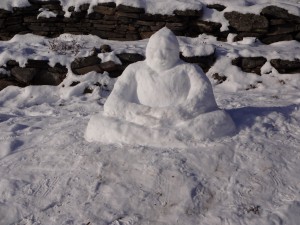Friday
Dharma TeachingsSo Much is at Stake, 4
 Lineage Stories
Lineage Stories
Maintaining the Heart of Practice
Part 4
by Acharya William McKeever
photos by Jessica Bizub and Patricia Hayward
I am often asked to tell lineage stories, so here is one that came to mind for today. It involves a great spiritual love affair that blossomed between Trungpa Rinpoche and Shibata Kanjuro Sensei, the 20th generation bow maker to the Emperor of Japan, and kyudo (Japanese Zen archery) master, who first visited us in Boulder from his family home in Kyoto in 1981. A special, close relationship rapidly developed between this unlikely pair — a Tibetan Buddhist master and this traditional Japanese master of bushido who spoke very little English. The Shibatas were renowned for a kyudo ritual which went back 20 generations when the first Shibata shot and killed a demon that was making the young Emperor of Japan mortally ill. This event is ritualized in the Shihobarai ceremony, the purification of the four directions, and it involves shooting two arrows into a close target with a special cry for each ya, or arrow.
The year was 1983, I believe, and Trungpa Rinpoche was teaching an advanced Shambhala program at Chateau Lake Louise in Alberta, Canada. Shibata Sensei had just flown nonstop from Kyoto to Calgary and was then driven to Lake Louise, arriving just in time for Trungpa Rinpoche’s evening lecture. The topic was the inner meaning of the warrior’s cry, “Ki Ki So So.” There is much that can be said here, but for these purposes we can simply say that “Ki” cuts through the fabric of doubt-ridden, setting sun dualistic mind, and “So” expands into that sacred space. Sensei sat up front near Rinpoche and assumed the Japanese stance of looking as though he were deep in thought (but which can also be a way to take a nap discreetly!). At the end of the lecture, as I was taking Sensei up to his suite, Rinpoche called me over: “Find out what Sensei thought of the talk — I think he was asleep, but find out.”
When I asked Sensei what he thought of the talk, he laughed and said, ”Rinpoche wants to know if I was asleep…. I know, I know, this KI KI SO SO. Same as in Shihobarai. First ya cuts through all obstacle and danger, second ya expands into sacred space. Shihobarai and KI KI SO SO, same same.”
 When I reported this back to Rinpoche, he was delighted and said how much he appreciated how well Sensei understood him. He said that he felt safer when Sensei was nearby. I asked him what the attraction was for Sensei, and Rinpoche explained using the structure of the three lineages, which are the three ways in which enlightened masters transmit their wisdom. The first is the ear-whispered lineage, those who convey awakenment by the spoken word. The next are the symbolic lineage masters, who transmit the awakened state by the use of nonverbal symbols. The highest masters are called the mind lineage of the Vidyadharas, who can transmit the awakened state of mind directly from mind to mind. Rinpoche explained that Sensei was a symbolic lineage master, and that the mind lineage had died out in modern-day Japan. Each lineage yearns for the higher one, so Sensei yearned to meet a mind lineage master, whom he had finally met in Trungpa Rinpoche.
When I reported this back to Rinpoche, he was delighted and said how much he appreciated how well Sensei understood him. He said that he felt safer when Sensei was nearby. I asked him what the attraction was for Sensei, and Rinpoche explained using the structure of the three lineages, which are the three ways in which enlightened masters transmit their wisdom. The first is the ear-whispered lineage, those who convey awakenment by the spoken word. The next are the symbolic lineage masters, who transmit the awakened state by the use of nonverbal symbols. The highest masters are called the mind lineage of the Vidyadharas, who can transmit the awakened state of mind directly from mind to mind. Rinpoche explained that Sensei was a symbolic lineage master, and that the mind lineage had died out in modern-day Japan. Each lineage yearns for the higher one, so Sensei yearned to meet a mind lineage master, whom he had finally met in Trungpa Rinpoche.
Here is one more story. This one involves keeping the big view, staying mindful of the greater implications of our meditative training. Maintaining this view is vital to maintaining an ongoing practice.
About twelve years ago, in early September, I was in a small retreat with the Nyingma Lama Chokyi Nyima Rinpoche. The date of the retreat was September 9-11, 2001. After a long day of teachings on September 10, Rinpoche and all of us were tired as we left the meditation room. Before we all departed, Rinpoche called us back into the hall, saying he had something important to tell us. He looked unbelievably sad, almost as if he had a premonition of the next day’s events, and he told us the following:
“As human beings we are capable of unbelievable acts of aggression and cruelty. We are also capable of unbelievable acts of kindness and compassion. Whichever of the two occurs, it always starts with individual thoughts. That is why we train the mind in shamatha and vipashyana meditation, to calm and strenghthen the mind. That is why we train the mind in tonglen and the paramitas, to cultivate wisdom and compassion. Because so much is at stake. So much is at stake.”
We went to bed with this teaching and awoke with it fresh in our minds the next day — which was 9-11. So much is at stake….so much is at stake.
Keep this in mind, hold it in your heart, as you depart this luminous hall and seek to combine the path of meditation and warriorship into your daily life. Because so much is at stake.
















